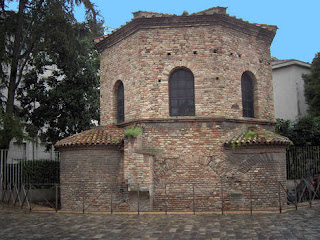Born in Rome, Agapitus was the son of a priest named Gordian, who was murdered during riots in Rome. Agapitus was Archdeacon of the priests of Rome, Italy. Elected pope when a very old man, he reigned for less than a year, and he died while on a failed mission to prevent the invasion of Italy by Justinian. In his tenure as pope he succeeded in having the Monophysite Patriarch of Constantinople, Anthimus, replaced by the more orthodox Mennas.
~ Commemorated on April 17 [22] --Sainted Agapitus I, Pope of Rome, was a zealous adherent of Orthodoxy. By his pious life he won the general esteem and was elevated to the papal throne in the year 535. The Gothic king Theodoric the Great dispatched Pope Agapitus to Constantinople for peace negotiations. Along the way Saint Agapitus encountered a lame and speechless man. He healed him from his lameness, and after partaking the Holy Mysteries the mute one spoke. At Constantinople the saint healed a blind beggar. In Constantinople at this time was convened the Local Church-Council. Saint Agapitus took part in it and zealously defended the Orthodox teaching against the heretic Severus, who taught, that the Body of the Lord Jesus Christ was subject to decay similar to every man's body. Saint Agapitus died at Constantinople in the year 536.
© 1996-2001 by translator Fr. S. Janos. ~
More detailed data can be found here.
More of the history of this period to be found on Irenikon here.
An Arian Baptistry in Ravenna:
Background: The Ostrogoths or "bright" Goths were the branch of the Goths that were subjected to the Hun army. Upon the withdrawal of the Huns from Europe, the Ostrogoths existed as a powerful Germanic tribe. In 489AD, Theodoric became King of the Ostrogoths. By 493AD, the Ostrogoths had become the sole Barbarian rulers of Italy. Theodoric had an enlightened reign that returned order to Italy, a reign that has been called by some the first Renaissance. National disorder returned once again upon Theodoric's death in 526AD. Finally in 541AD, the Eastern Roman Empire invaded Italy engaging the Ostrogoths for twenty years.
The Arian Christian Ostrogoths eventually were defeated in 563AD leaving a disastrous power vacuum in Rome, something that St. Pope Agapitus the First desperately had tried to forestall by risking his life, essentially, to make the journey to Constantinople to plead with Emperor Justinian to allow the peninsula and Rome, with the Ostrogoths, to grow and develop and come to the faith in a natural way without war and conquest.
The idea that the nasty Ostrogoths were driven out by the luminous Justinian is not precisely a balanced view of what was really happening in Rome under the rule of Theodoric. In fact Justinian, egged on by his wife the Emperess Theodora, waged a brutal and bloody campaign of counter-expansion and forced religious conversion against the west, that raged across Europe all the way to Britain. Pope Agapitus I foresaw the damage that kind of attack would do to the region and he little trusted Empress Theodora who was more than happy to put a heretic on the Patriarchial throne in Constantinople, a move which her compliant husband barely noticed.
The face of the conflict between Rome and Constantinople changes aspects somewhat when history, on the rare occasion, is told by the conquered rather than the conquerers. From the point of view of genuine and lasting faith and religious conversion, the greatest lesson to Constantinople from that period, at a price the west continues to pay, ought to be that forced conversions and the spread of Christianity by the power of the sword, is a lost and dangerous cause...to those whose souls are only partially captured. Warped and twisted faith is often far worse than no faith at all. The current Orthodox idea that the west is the only one guilty of such behaviors is simply not upheld in the history of the Church.


yurtdışı kargo
ReplyDeleteresimli magnet
instagram takipçi satın al
yurtdışı kargo
sms onay
dijital kartvizit
dijital kartvizit
https://nobetci-eczane.org/
L8Q8
Nijerya yurtdışı kargo
ReplyDeleteNijer yurtdışı kargo
Nevise yurtdışı kargo
Nepal yurtdışı kargo
Namibya yurtdışı kargo
35E
Bermuda yurtdışı kargo
ReplyDeleteBonaire yurtdışı kargo
Bolivya yurtdışı kargo
Birleşik Arap Emirlikleri yurtdışı kargo
Bhutanya yurtdışı kargo
GS8P
رش مبيدات
ReplyDeleteصيانة بوتاجاز مكة kTrjscebZR
ReplyDeleteصيانة بوتاجاز مكة 8igOVcJQBO
ReplyDeleteشركة تسليك مجاري بالدمام wHRqin4hl2
ReplyDeleteتسليك مجاري بالاحساء AcWdYr94wu
ReplyDelete